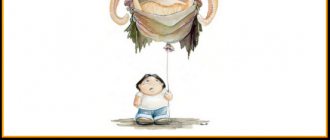Homo sapiens has a feeling of fear, and has always been so. This is an emotional reaction of the body that plays the role of protection and encourages one to avoid danger. However, there is also an increased fear of any situation, object, or action. For a normal existence, treatment of fears and phobias is necessary.
It got its name from the Greek word "phobos", that is, fear - phobia. A person suffering from this mental illness is afraid of something imaginary in the present, and in certain cases this feeling becomes aggravated, and an unreasonable feeling of anxiety, restlessness and even panic arises.
For example, you are in the cabin of a flying airplane, and it enters a zone of turbulence and begins to shake, and you are scared - this is real fear. But if the mere thought of flying makes you sweat, then this is already a phobia. The individual is unable to explain such logical moments; he understands that it looks stupid, but he can’t do anything.
Phobic reactions change a person’s normal behavior, interfere with his life, and often put him in awkward situations. This is a big problem and needs to get rid of it. It is unlikely that you will be able to do this on your own. The specialists of our Psychoendocrinology Center will help you cope with fears of this kind.
Causes and symptoms
Experts cannot name the only reason that causes phobias, but, as a rule, this is an echo of negative childhood experiences. However, an adult can also find himself in a situation that leaves a significant imprint on the psyche. Often people simply forget that bad things happened to them before, but for some adults they emerge in the subconscious - the connection between the incident and the emotions experienced is deposited in it.
There is an opinion that obsessive fear can be inherited and “triggered” after stress. A heightened instinct of self-preservation also contributes to the emergence of phobias.
As for the signs of this mental disorder, they are as follows:
1. The desire to avoid the situation causing the phobia by any means.
2. Feeling of a lump in the throat, inability to breathe.
3. The whole body is shaking.
4. Rapid heartbeat - the heart literally “breaks out” of the chest.
5. The appearance of sticky cold sweat.
6. Weakness in the body, it stops listening, immobilization.
7. Terrible fear.
8. The stomach hurts, there may be loose stools, vomiting.
The most common phobias
A phobia is a manifestation of irrational fear or increased anxiety associated with real or expected objects or situations that cause fear. This is an obsessive state that worsens under specific conditions and cannot be explained logically. Under the influence of a phobia, a person is afraid and tries to avoid certain situations, activities or objects.
Below is a list of the most common phobias in alphabetical order:
- Agoraphobia is the fear of open spaces. People with this fear prefer to always be indoors.
- Aquaphobia is the fear of water. In its hypertrophied form, it can develop into a fear of drinking even a sip of water.
- Acrophobia – fear of heights. Fear causes climbing to any heights, from a stool to mountains.
- Arachnophobia is the fear of spiders. It is considered characteristic of most people in the world.
- Astraphobia is the fear of thunder and lightning. A very common fear that causes people to take shelter during a thunderstorm.
- Aerophobia is the fear of flying and aircraft. It is a hindrance for many people who want to travel.
- Hemophobia is the fear of the sight of blood. At the sight of blood, even on TV, a person with such a phobia may lose consciousness.
- Gerontophobia is the fear of old age. Most often, this fear is observed in middle-aged people.
- Homophobia is fear, or rather rejection, of homosexuality and people with non-traditional sexual orientation.
- Dentophobia is the fear of dentists. People with this phobia would rather endure severe toothache than sit in the dentist's chair.
- Kacorrhaphiophobia is the fear of failure. Characteristic mainly of people focused exclusively on success.
- Cynophobia – fear of dogs. Another type of phobia that is common to a huge number of people.
- Claustrophobia is the fear of closed spaces. A person with an aggravated form of this phobia begins to panic in an ordinary elevator.
- Xenophobia is the fear of strangers. It can develop on sexual, interracial and religious grounds.
- Mysophobia is the fear of germs and dirt. A person with this fear is uncomfortable touching any objects outside his home, where there is always perfect cleanliness.
- Monophobia is the fear of loneliness. It can be expressed as a fear of being abandoned by a loved one, being alone in the world, or being alone in a room.
- Necrophobia is the fear of the dead. A clear example of fear of the unknown.
- Nyctophobia is the fear of the dark. Despite the fact that it mainly affects children, it is also observed in a huge number of adults.
- Ophidiophobia is the fear of snakes. Another example of a common fear. It is a subtype of hypertophobia - fear of reptiles.
- Social phobia is the fear of public attention. This can even include the fear of appearing in public places.
- Thanatophobia is the fear of death. This fear paralyzes a person’s will and prevents him from living a normal life.
- Trypanophobia – fear of needles, pricks and injections. A regular vaccination becomes a test of strength for people with this phobia.
- Trypophobia is the fear of open wounds and any holes in the skin, both on one’s own and on the skin of any living organism in general.
We, of course, could list a dozen other common phobias, but if you wish, you can do your own little research, for example, read what people are afraid of on the Internet. And we will add some zest to our article and briefly list some of the strangest phobias found in the modern world:
- agmenophobia – fear that the queue a person is standing in will move slower than the one next to it;
- acribophobia - fear of not understanding the essence of what you read;
- hapotophobia – fear of being touched;
- hexakosioyhexekontahexaphobia – fear of the number “666”;
- genophobia – fear of intimacy;
- hippopotomonstrosesquipedalophobia – fear of long words;
- dextrophobia – fear of objects located on the right;
- decidophobia – fear of making decisions;
- Domatophobia – fear of houses and any buildings;
- dorophobia – fear of giving and receiving gifts;
- Ignorophobia – fear of not receiving a response to a message you read;
- Imojiphobia – fear of being misunderstood after sending an emoticon or sticker;
- cyberphobia – fear of computers;
- kumpunophobia – fear of buttons;
- Lacanophobia – fear of vegetables;
- macrophobia – fear of long waits;
- nephophobia – fear of clouds;
- nomophobia – fear of being without a smartphone;
- omphalophobia – fear of belly buttons;
- Papaphobia – fear of the Pope;
- penteraphobia - fear of mother-in-law;
- Pogonophobia – fear of beards;
- punctumophobia – fear of messages with a period at the end;
- reterophobia – fear of making a mistake in a word or not seeing an erroneous autocorrect;
- Selfiphobia – fear of taking a poor-quality selfie;
- social network phobia – fear of social networks;
- philophobia - fear of falling in love;
- Chairophobia – fear of laughing in inappropriate conditions;
- Chorophobia – fear of dancing;
- chronophobia – fear of time;
- epistemophobia – fear of gaining knowledge;
- Ergophobia – fear of any work.
And this list of phobias does not exhaust the topic, which suggests that it is possible to find some kind of fear, even in a mild form, in almost any person in the world. Moreover, with the passage of time and changes in the specifics of each era, new, sometimes completely absurd, fears appear.
Of course, we sincerely hope that no fears or phobias cause you discomfort in life. If this is still not the case, read our article “Fear. What should you do with him?” in order to better know your enemy and overcome him. However, getting acquainted with this article is useful and simply for general development.
We wish you good luck and successful work on yourself, no matter what it concerns!
We also recommend reading:
- Storytelling
- How to cope with fear: a selection of useful materials
- Interesting and unusual facts about fear
- How to deal with fears
- Your main fear
- Systematic desensitization method to combat fears
- What is fear and how to overcome it
- How to overcome the fear of a white page
- Fear: psychological foundations and famous scientific studies of this phenomenon
- Overcoming Fear
- Psychology of fear
Key words:1Psychoregulation
How to get rid of phobias
As already mentioned, obsessive fears worsen the quality of life, prevent one from realizing oneself in the desired profession, traveling, etc. It is impossible to cope with phobias spontaneously and on your own. Our Center's specialists are ready to help people with similar problems.
Successful complex treatment is carried out by experienced psychotherapists using physical and psychotherapy, using a small amount of medications (this is the policy of our Center). The patient, thanks to the efforts of specialists, understands the cause of his phobia, which allows him to completely get rid of it and never again be afraid of unreal dangers.
Forms of fears
Fears can be classified according to different criteria. We will talk about some of them below, but for now we will consider the classification of emotional states that are in one way or another related to fear, based on the intensity, objectivity and strength of perception. Everything here is extremely simple, because you yourself are familiar first-hand with such things as:
- Calm. A state of complete emotional peace, when nothing worries a person, he is comfortable psychologically, he does not experience any negatively colored states associated with fear.
- Anxiety (fear, worry). A state in which a person feels the uncertainty of the situation and expects a bad turn of events. Most often, anxiety has no objective stimulus and is irrational.
- Excitement. A condition arising from anxiety and representing its intensified form. With it, a person experiences more intense nervous excitement, because doesn’t know what could happen to him and is afraid of it.
- Fear. A condition caused by a real or perceived threat. Let us remember that there is a healthy fear that warns against danger, and there is an unhealthy fear that has no basis. This is what you need to be able to cope with.
- Horror. A condition caused by intense fear. It can plunge a person into numbness, trembling, shock. A person’s active reaction to horror is absent; he is unable to eliminate the source of fear.
- Panic. A condition that is another extreme form of fear, but it is not expressed in numbness, but in the fact that a person begins to be controlled by his feelings. His actions are not subject to any logic and often harm him.
We can also identify another condition associated with fear. This is a state of fearlessness. In the case of a real threat, it can lead to extremely dire consequences. A state of fearlessness can be observed in people with an exaggerated and unhealthy sense of self-confidence, people who do not have a sense of self-preservation and suffer from mental disorders (we are not talking about situations where circumstances require being fearless).
But this is only an initial classification of fears, giving a general idea of how fear can be expressed in general. Next we present another classification - developed by the Soviet and Russian psychiatrist and psychotherapist Boris Dmitrievich Karvasarsky. He divided fears into eight large groups:
- Spatial fears (this includes bathophobia - fear of depth, acrophobia - fear of heights, agoraphobia - fear of open space, claustrophobia - fear of enclosed spaces, etc.)
- Social fears (this includes neophobia - fear of any change, heterophobia - fear of the opposite sex, etc.)
- Fear of diseases.
- Fear of death.
- Fear of sex.
- Fear of harming others.
- Fear of fears (it is this fear, by the way, that causes all phobias).
However, the classification of fears by B. D. Karvasarsky is quite complex and relative. The Austrian psychologist and psychiatrist Sigmund Freud approached the categorization of fears more specifically, dividing fears into two classes:
- real fears;
- neurotic fears.
Canadian-American psychiatrist Harold Irwin Kaplan classified fears in a similar way. He divided them into:
- constructive fears;
- pathological fears.
But the most interesting thing is that these two scientists agreed that the first fears (real and constructive) are necessary for a person so that he can save his own or someone else’s life, and the second (neurotic and pathological) can be considered as a sign of an illness that destroys a person .
There is also an interesting theory from stress research specialist Yuri Viktorovich Shcherbatykh, proposed by him in 2000. According to his concept, there are three types of fears:
- Natural fears. This includes everything that is justified by natural phenomena (hurricanes, earthquakes, tsunamis, thunderstorms, etc.). Such fears are completely justified and even adequate people are susceptible to them. It is human nature itself to fear everything unknown (we repeat once again that we talked about this in the article “Fear. What to do with it?”, as well as in the article “Psychological foundations of fear”). Despite the fact that today people perfectly understand the origin of most natural phenomena, fear of them remains, and it is natural. This category of fears also includes the fear of various animals, insects and other living creatures.
- Social fears. Yu. V. Shcherbatykh, taking as a basis the results of various sociological surveys, came to the conclusion that the greatest fear among people is, of course, the threat of war. And this fear is characteristic even of those who have never participated in hostilities. Among other social fears, he names fear of crime, hooliganism and disorder, fear for one’s loved ones, fear of death, fear of poverty, fear of public speaking and publicity in general, fear of change and some others.
- Inner fears. As children, many of us were frightened by some kind of woman or little gray wolf who would come and take us away if we did not obey. We have grown up, but many people still have the fear of looking in the mirror at night, looking under the bed, or pulling their leg out from under the blanket. A person’s imagination, which received the corresponding message in childhood, is capable of generating a variety of monsters that no spiders or hurricanes can compare with. And it is very, very difficult to stop being afraid of such things (by the way, read our article “What Famous People Were Afraid of,” where there is a lot of confirmation of what was said).
The line between these three groups of fears is very thin and extremely difficult to see. For example, if a person experiences internal fear of the quagmire that is sucking him in, it can to a certain extent be attributed to both social and natural fear. Fears can cleverly intertwine with each other and have an inexplicable impact on a person.
But the classification of fears does not end there, because there is also a gradation by age:
- Childhood fears. When a child just begins to live, his gene stock of reflexes works. So, the baby may be afraid of being thrown up when he hears loud noises or sees strangers. Such reactions are normal and constructive, but life moves on. If parental upbringing was incorrect or the child was influenced by some special circumstances, he may develop neurotic fears. For example, if a child was punished by being locked in a closet, he may develop claustrophobia, and if his mother once lost him in a shopping mall, he may begin to fear open spaces and large crowds of people.
- Fears of an adult. An adequate adult understands perfectly well that there is no Boogeyman in a dark closet, but he can be terrified by the mere sight of snakes, spiders or praying mantises. Likewise, he may be afraid that a loved one will leave him, or experience stage fright; to be afraid of being worse than others or to consider oneself unworthy of many benefits; overly control your other half or constantly worry about your children, etc.
- Fears of older people. The fears of older people may differ from those of children and adults. They are specific. In addition to the fear of the dark, mice and hurricanes, there may be a fear of getting sick and becoming a burden to your family. But at the same time, the fears that previously bothered us disappear, for example, the fear of being misunderstood by others, the fear of not experiencing love in life. However, some fears can go to extremes: grandmother, afraid of strangers, does not open the door even to her relatives, grandfather, fearing transport, does not come closer than 200 meters to the road, etc.
This is the primary classification of fears. In fact, this topic is worthy of more careful study and serious scientific work. But we only set ourselves the task of showing how diverse this unique phenomenon called fear is, and we hope that we were able to accomplish this task.
You can read about how to work with fears in the articles “Fear. What to do with him?" and “Method of systematic desensitization to combat fears,” and we will continue this material with very interesting information. As you know, fear can become uncontrollable and obsessive, i.e. develop into a phobia. So below we will talk about the most common phobias of people.
Famous people and their phobias
Perth First was afraid of cockroaches. At that time they were present in many houses and taverns. In order to avoid encountering barbels once again, he asked one of his escorts to explore the premises. If everything was clean there, Peter would come in.
Grasshoppers are considered the most harmless insects, but for some reason Salvador Dali was afraid of them. As a child, his peers laughed at him because of this, trying to throw several copies into his bag.
Walt Disney was terribly afraid of mice! This seems so absurd, especially remembering who became the creator of the main cartoon mouse - Mickey Mouse.
Alfred Hitchcock knew a lot about fear. His films still evoke different emotions in viewers. He himself had a strange relationship with eggs. Not only did he not eat them, but he was even afraid to touch them. They disgusted him.
Napoleon was afraid of cute creatures - cats, and most interestingly - white horses. He had to ride a lot on horseback or in a carriage, but he could never see a white horse next to them.
Churchill was afraid to speak publicly. Seems funny too. After all, he stood at the podium so many times and addressed a large audience. He tried to suppress his fear, so he became a good speaker, able to persuade.
Storyteller Anderson was afraid that he would be buried alive. This fear was so strong that when he was sick, he tried to leave a note on the bedside table with the inscription: “It only seems to you that I am dead, in fact I am sleeping.”
What are the main treatments for phobias?
The main method of treating phobias is psychotherapy, based on the presentation of a phobic disorder as a conditioned reflex to a stressful stimulus that has not completed extinction. This incomplete process is caused by the patient's avoidance of situations and objects that frighten him. If you resort not to avoidance, but, on the contrary, to constant and gradually increasing exposure to a frightening factor, then the conditioned reflex of the phobia will fade away over time. This rapprochement with the object of fear is achieved by combining the relaxation method and cognitive behavioral therapy, the so-called systematic desensitization. By the way, rapprochement can be both real and virtual, but it is based on a change in the patient’s incorrect beliefs regarding the danger of a situation or object. In fact, the psychotherapist works with the patient using methods of relaxation training and reality checks. Usually it takes 15-20 sessions to get rid of a phobia. In addition to desensitization, other techniques have been developed for working with patients suffering from phobias. These include behavioral therapy, paradoxical therapy, implosive therapy and gestalt therapy.
In some cases, drug treatment is indicated, but it should be combined with psychotherapy with extreme caution, because for psychological correction to be effective, the patient must experience a feeling of fear. If it is suppressed with medication, then psychotherapy will not achieve its goal. The choice of drug therapy is made when they want to get a quick result or when phobias are combined with other mental disorders, for example, depression, neurosis, etc. The following drugs are mainly used:
• Antidepressants, the tricyclic antidepressant imipramine is quite effective, as well as SSRIs and MAO inhibitors. • Anxiolytics (tranquilizers) of the benzodiazepine group to reduce anxiety. • Sometimes low dosage antipsychotics. • Sedatives.
When treating phobias with medication, only a doctor - psychotherapist or psychiatrist can prescribe drugs, monitor the effectiveness of therapy and cancel treatment. It should also be remembered that medications provide only a temporary effect; after completing the course of drug therapy, symptoms of phobias and fears may return. Therefore, without the help of a psychotherapist, it will not be possible to achieve lasting positive results and complete relief from phobias. Therefore, the sooner the patient seeks help, the simpler, easier and more effective the treatment will be.
What is the differential diagnosis of phobias based on?
Exaggerating, we can say that if a person is afraid, this is fear, and if he is afraid and avoids, then this is a phobia. But it's not that simple. In differential diagnosis, it is necessary to distinguish phobias from obsessive fears, post-traumatic syndrome and some other mental disorders. For this purpose, a self-assessment of the level of anxiety on the Zang scale is often used, but only a specialist (psychotherapist or psychiatrist) can make a reliable diagnosis of phobia based on knowledge, experience and a medically recognized classification.
How does a phobia differ from obsessive fear? With a phobia, fear occurs only in specific situations and in the presence of an object with which the phobia is associated. With obsessive fear, a person begins to be afraid and anxious even at the thought of the possibility of meeting an object. For example, he may check the bed many times to make sure there are no spiders or snakes, or constantly measure blood pressure and pulse in case of obsessive fear of a heart attack or hypertensive crisis. We can say that a phobia is a less severe problem compared to obsessive fear.
To differentiate a phobia from PTSD (post-traumatic stress disorder), it is important to know that in the latter case there must have been mental trauma, as a real threat to life, safety and health. With a phobia, the object may not be personally experienced as a real danger; the person may simply be a witness to something that threatens others, or may perceive the stories of eyewitnesses too vividly. But experiences with a phobia tend to be revived when meeting an object, even only in imagination or mention of it. In PTSD, re-experiencing a traumatic experience occurs spontaneously, independent of flashback-like memories.
Is it possible to overcome a fear or phobia?
To learn more about yourself and your fears, you can study the Human Design System. Pay attention to the splenic center Ajna and the solar plexus area. They are responsible for human fears caused by the mind, speculation, and the third sense. When a splenic person thinks with his mind, he harms himself, and when an emotional person listens to his mind, he harms himself and those around him. A person with a certain emotional center at the peak of the wave may not notice the danger. The calculation of the rave card shows in which area your talents, strengths and weaknesses manifest themselves. You will also learn about fears: why they appeared, how to deal with them. The information will help you choose the future path of development for you as an individual and professional.











